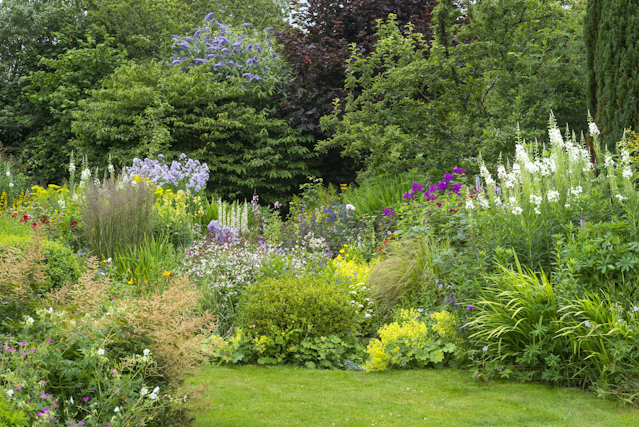The Definitive Perennial Guide
Master the art of growing perennials in the Peace Region. Learn essential tips for planting, maintenance, and care to enhance your garden's beauty and longevity.

Perennials are the backbone of nearly every flower garden. Unlike annual plants that need to be planted each year, most perennials die to the ground in the fall and regrow from the same roots or bulbs the following spring. In most cases perennials will send up more shoots or grow additional bulbs from year to year.
People grow perennials because they are easy to care for, dependable, and they have an enormous variety of colour, texture and form.
Some perennials are short lived, like lupins, delphiniums, malva and Heuchera, and some can grow for fifteen years or more like Goatsbeard, Fals Indigo, Ladies Mantle and yet some like Peony’s can grow for a lifetime.
Bloom time for each perennial can vary from two weeks of blooms per year to two to three months of blooms in a year.
Each perennial has different needs for how much sun each day they require. Some can handle full shade and other’s part shade to part sun to full sun. When buying perennials, they will generally come with a tag with info on sunlight requirements.
How to Select Plants
When selecting perennials for the yard we usually succumb to the beautiful blooms and decide later where to plant them. This can work, but probably most importantly we should select perennials that would be ideal for the location we have available.
The Site
Perennials like all plants will flourish and be healthier if planted in a location that suite them. Things to consider, does the site have full sun (6-8 hours of direct sunlight per day), part sun( 4-6 hours of direct sunlight per day)part shade(2-4 hours of direct sunlight per day ideally morning or evening sun), full shade(2 hours or less of direct sunlight per day). Does the soil stay moist or does it dry out between rains. Is the soil pH acidic or alkaline (most perennials like a pH of 6.5)? Where you’re planting the perennials is the bed sloped, steep or flat? Perennials do best in well drained soil, adding peat moss, manure, and compost to the top 8” of soil will be a great start before planting.
Hardiness
Knowing your zone and planting your perennials within the zone are extremely important for their success in coming back the next growing season. The peace country is zone 2 and 3. But also knowing where in your yard has consistent snow cover can be beneficial in shifting your hardiness location to one zone hardier. It is very rewarding to discover that you can plant a few zone 4 or even 5 perennials in your yard. Well drained soil is also beneficial. Heavy and wet locations can rot bulbs or damage roots.
Vigar & Height
Vigar can be good, but it also can be a problem. Researching your perennial before you plant can be a huge benefit. If your plant research says it spreads or is invasive make sure you have edging or boundaries surroundings your perennial or it might invade places you didn’t want. Or if you have a large space, you want filled these spreading perennials, this will help make your live easier by filling in the space nicely. Height is another thing to consider before planting your perennials. Just make sure the perennial you plant doesn’t block your view from a window in your house or crowd other plants in your flower bed. And planting the taller plants in the back or the center of the bed with shorter ones around the border. Investing in a good quality plant stake or cage and putting it around the perennials in early spring when plants are small or haven’t emerged from the ground yet will save you the headache of trying to get that ‘now grown’ perennial in a cage or staked.
Here are just some perennials that will want to take control on their own: 😊
- Gout weed
- Boungle weed
- Lamium
- Strawberries and Cream Ribbon grass
- Lisamchia
- Lily of the Valley
- Anemone
- Bellflower
- Chinese Lantern
Fertilizing
Perennials like all plants will benefit from applying bone meal and transplanter at the time of transplanting. Springtime is the best time to apply a perennial fertilizer around established plants, scratching it into the top of the soil, reapplying in July keeps them thriving until fall. Top dressing with manure or compost every spring will restore trace minerals and improve soil texture and water retention.

Watering
Keep your perennials well watered the first year to get them established. A quick drink everyday promotes spindly roots. Instead, water deep and less frequent to encourage and promote long and healthy roots. Perennials that have a good, developed root system can handle drought, disease and insects better. Mulching around plants with leaves, dried lawn clippings or bark mulch will help keep weeds to a minimum and help retain moisture in the soil and will also look aesthetically pleasing.
Deadheading
Some plants drop their spent or finished flowers, others hold on to them all summer and even into the winter. Removing the spent flowers will encourage the plant to rebloom. It also prevents plants from putting their energy into seed production that could be used for a healthier root system and plant. If you are collecting seeds from your perennials, then leaving the spent flower on until dry is best for harvesting seeds.
Dividing
Your perennials might need dividing if they are flowering less, flowers are getting smaller, they are running out of space or if you notice that the centre of the plant is dying out leaving a bare middle section. It’s best to divide perennials early spring or in the fall when the plant has gone dormant. They shouldn’t be divided when they are blooming or in full growth. Use a shovel to remove the whole plant. Divide into sections or quarters with a, fork, knife or shovel. Leave one portion in the ground and plant the other portions in a new location. Use bonemeal and transplanter to help stimulate the roots to take off.
There are two perennials that should not be divided in the spring; Herbaceous Peonies like to be divided in late fall. Bearded Iris prefers to be divided mid to late summer, dividing them helps the replanted portion to develop a root system before fall.
Fall Prep
Before winter sets in, cut all your perennials down to the ground. Or leave seed pods for winter interest or food supply for birds. Early spring is the next best time to cut back your perennials before they start growing. Water your perennials deeply before the ground freezes, this could be at different times from year to year. Mulch any perennials you feel that are borderline hardy for your area or that need that extra protection from the wind or that won’t get a lot of snow cover. Be aware of warmer temperatures in the winter, if there is no snow cover and the soil has dried out you may need to water.
Why do perennials have two names?
It may be hard to believe, but scientific plant names are used to avoid confusion and not create it. The scientific plant name was developed to ensure the same plant is called the same name throughout the world, regardless of language. They are usually a combination of Latin and Greek.
Common names like Bleeding Heart are referred to all the plants in that genes. But there are many types of Bleeding Hearts. Dicentra spectibilis ‘Alba’(old fashion white bleeding heart) The genes name of the Bleeding Heart is Dicentra, always capitalized. The second name is the species, it is not capitalized. And the third name is ‘Alba’ the variety.
Perennials That Thrive in the Peace Country
- Peonies
- Lilies
- Delphiniums
- Tulips
- Bleeding Hearts
- Irises
- Karl Forester Grass
- Hostas
- Ligularia
- Fiddlehead ferns
- Sedum(Stonecrop)
- Daylilies
- Creeping Phlox
- Poppies
- Hollyhocks
- Lamium
- Hen and Chicks
Perennials That Like Shade:
- Ferns
- Hostas
- Lamium
- Ligularia
- Astilbe
- Brunnera
- Sweet woodruff
- Solomons Seal
- Bergina
- Lily of the Valley
- Ajuga
- Bleeding Heart
- Wild Ginger
- Heuchera
Deer-Resistant Perennials
Sadly there is no such thing as deer proof but rather deer resistant. What deters deer are the strong scented plants and the fuzzy leaves. Also, young deer will be more inclined to taste or try every plant and will determine which plants to eat and which ones that aren’t as pleasant.
- Achillea(Yarrow)
- Alyssum
- Bleeding Heart
- Brunnera
- Columbine
- Coreopsis(Tickseed)
- Daffodil
- Delphinium
- Echinacea(Coneflower)
- Foxglove
- Helenium
- Iris
- Lamb’s Ear
- Lychnis
- Oriental Poppy
- Monarda(Bee Balm)
- Myosotis(Forget Me Not)
- Nepeta
- Peony
- Pulmonaria
- Rodgersia
- Russian Sage
- Salvia
- Thalictrum
- Veronica

